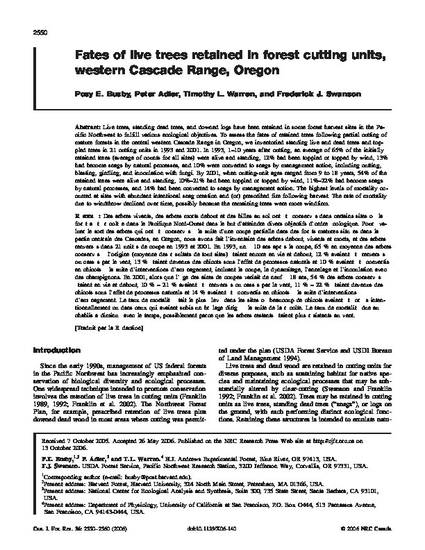
Article
Fates of live trees retained in forest cutting units, western Cascade Range, Oregon
Canadian Journal of Forest Research
(2006)
Abstract
Live trees, standing dead trees, and downed logs have been retained in some forest harvest sites in the Pacific Northwest to fulfill various ecological objectives. To assess the fates of retained trees following partial cutting of mature forests in the central western Cascade Range in Oregon, we inventoried standing live and dead trees and toppled trees in 21 cutting units in 1993 and 2001. In 1993, 1–10 years after cutting, an average of 65% of the initially retained trees (average of counts for all sites) were alive and standing, 12% had been toppled or topped by wind, 13% had become snags by natural processes, and 10% were converted to snags by management action, including cutting, blasting, girdling, and inoculation with fungi. By 2001, when cutting-unit ages ranged from 9 to 18 years, 54% of the retained trees were alive and standing, 10%–21% had been toppled or topped by wind, 11%–22% had become snags by natural processes, and 14% had been converted to snags by management action. The highest levels of mortality occurred at sites with abundant intentional snag creation and (or) prescribed fire following harvest. The rate of mortality due to windthrow declined over time, possibly because the remaining trees were more windfirm.
Disciplines
Publication Date
2006
DOI
doi:10.1139/X06-140
Citation Information
Peter B. Adler. "Fates of live trees retained in forest cutting units, western Cascade Range, Oregon" Canadian Journal of Forest Research Vol. 36 (2006) p. 2550 - 2560 Available at: http://works.bepress.com/peter_adler/248/
